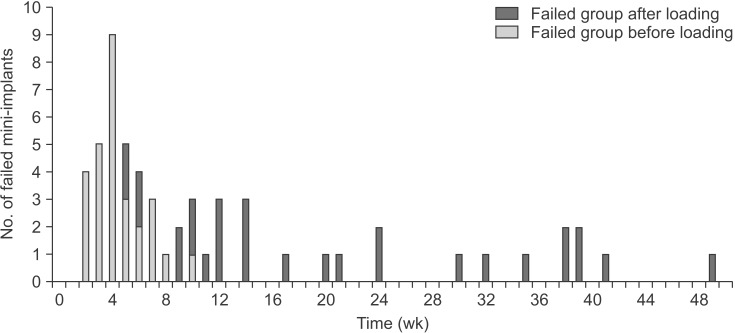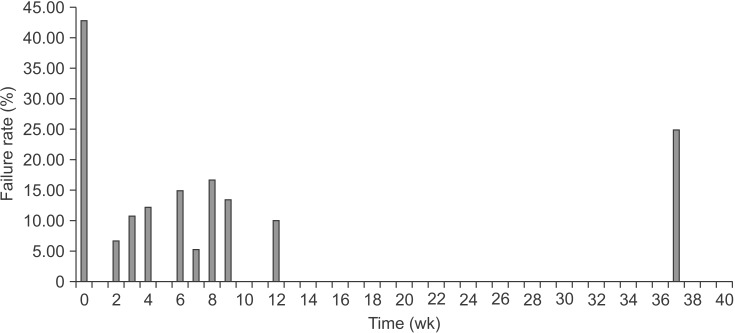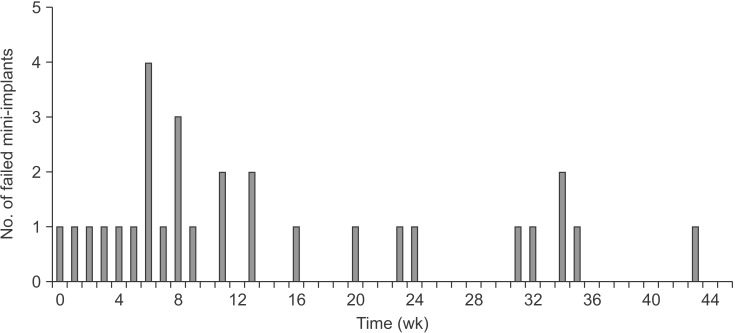J Korean Assoc Oral Maxillofac Surg.
2015 Oct;41(5):240-245. 10.5125/jkaoms.2015.41.5.240.
Analysis of time to failure of orthodontic mini-implants after insertion or loading
- Affiliations
-
- 1Department of Orthodontics, School of Dentistry and Dental Research Institute, Seoul National University, Seoul, Korea.
- 2Department of Orthodontics, Section of Dentistry, Seoul National University Bundang Hospital, Seongnam, Korea. kimjongwan@hotmail.com
- 3Department of Oral and Maxillofacial Surgery, Section of Dentistry, Seoul National University Bundang Hospital, Seongnam, Korea.
- 4Department of Oral and Maxillofacial Surgery and Oral Cancer Center, School of Dentistry and Dental Research Institute, Seoul National University Dental Hospital, Seoul, Korea.
- KMID: 2070437
- DOI: http://doi.org/10.5125/jkaoms.2015.41.5.240
Abstract
OBJECTIVES
This study was performed to evaluate patterns of failure time after insertion, failure rate according to loading time after insertion, and the patterns of failure after loading.
MATERIALS AND METHODS
A total of 331 mini-implants were classified into the non-failure group (NFG) and failure group (FG), which was divided into failed group before loading (FGB) and failed group after loading (FGA). Orthodontic force was applied to both the NFG and FGA. Failed mini-implants after insertion, ratio of FGA to NFG according to loading time after insertion, and failed mini-implants according to failed time after loading were analyzed.
RESULTS
Percentages of failed mini-implants after insertion were 15.79%, 36.84%, 12.28%, and 10.53% at 4, 8, 12, and 16 weeks, respectively. Mini-implant failure demonstrated a peak from 4 to 5 weeks after insertion. The failure rates according to loading time after insertion were 13.56%, 8.97%, 11.32%, and 5.00% at 4, 8, 12, and 16 weeks, respectively. Percentages of failed mini-implants after loading were 13.79%, 24.14%, 20.69%, and 6.9% at 4, 8, 12, and 16 weeks, respectively.
CONCLUSION
Mini-implant stability is typically acquired 12 to 16 weeks after insertion, and immediate loading can cause failure of the mini-implant. Failure after loading was observed during the first 12 weeks.
MeSH Terms
Figure
Reference
-
1. Suh HY, Lee SJ, Park HS. Use of mini-implants to avoid maxillary surgery for Class III mandibular prognathic patient: a long-term post-retention case. Korean J Orthod. 2014; 44:342–349. PMID: 25473650.
Article2. Kanomi R. Mini-implant for orthodontic anchorage. J Clin Orthod. 1997; 31:763–767. PMID: 9511584.3. Lee HJ, Lee KS, Kim MJ, Chun YS. Effect of bite force on orthodontic mini-implants in the molar region: finite element analysis. Korean J Orthod. 2013; 43:218–224. PMID: 24228236.
Article4. Herrmann I, Lekholm U, Holm S, Kultje C. Evaluation of patient and implant characteristics as potential prognostic factors for oral implant failures. Int J Oral Maxillofac Implants. 2005; 20:220–230. PMID: 15839115.5. Lee JH, Choo H, Kim SH, Chung KR, Giannuzzi LA, Ngan P. Replacing a failed mini-implant with a miniplate to prevent interruption during orthodontic treatment. Am J Orthod Dentofacial Orthop. 2011; 139:849–857. PMID: 21640893.
Article6. Wiechmann D, Meyer U, Büchter A. Success rate of mini- and micro-implants used for orthodontic anchorage: a prospective clinical study. Clin Oral Implants Res. 2007; 18:263–267. PMID: 17348892.
Article7. Kim JS, Choi SH, Cha SK, Kim JH, Lee HJ, Yeom SS, et al. Comparison of success rates of orthodontic mini-screws by the insertion method. Korean J Orthod. 2012; 42:242–248. PMID: 23173117.
Article8. Kim SH, Lee SJ, Cho IS, Kim SK, Kim TW. Rotational resistance of surface-treated mini-implants. Angle Orthod. 2009; 79:899–907. PMID: 19705943.
Article9. Grunder U. Immediate functional loading of immediate implants in edentulous arches: two-year results. Int J Periodontics Restorative Dent. 2001; 21:545–551. PMID: 11794565.10. Kim YK, Kim BS, Yun PY, Mun SU, Yi YJ, Kim SG, et al. The seven-year cumulative survival rate of Osstem implants. J Korean Assoc Oral Maxillofac Surg. 2014; 40:68–75. PMID: 24868503.
Article11. Ioannidou E, Doufexi A. Does loading time affect implant survival? A meta-analysis of 1,266 implants. J Periodontol. 2005; 76:1252–1258. PMID: 16101355.
Article12. Catharino PC, Dominguez GC, Pinto Ddos S Jr, Morea C. Histologic, histomorphometric, and radiographic monitoring of bone healing around in-office-sterilized orthodontic mini-implants with or without immediate load: study in rabbit tibiae. Int J Oral Maxillofac Implants. 2014; 29:321–330. PMID: 24683557.
Article13. Robling AG, Niziolek PJ, Baldridge LA, Condon KW, Allen MR, Alam I, et al. Mechanical stimulation of bone in vivo reduces osteocyte expression of Sost/sclerostin. J Biol Chem. 2008; 283:5866–5875. PMID: 18089564.
Article14. Klein-Nulend J, van der Plas A, Semeins CM, Ajubi NE, Frangos JA, Nijweide PJ, et al. Sensitivity of osteocytes to biomechanical stress in vitro. FASEB J. 1995; 9:441–445. PMID: 7896017.15. Forwood MR. Inducible cyclo-oxygenase (COX-2) mediates the induction of bone formation by mechanical loading in vivo. J Bone Miner Res. 1996; 11:1688–1693. PMID: 8915776.
Article16. Tatsumi S, Ishii K, Amizuka N, Li M, Kobayashi T, Kohno K, et al. Targeted ablation of osteocytes induces osteoporosis with defective mechanotransduction. Cell Metab. 2007; 5:464–475. PMID: 17550781.
Article17. Kim YK, Ahn KJ, Yun PY, Kim M, Yang HS, Yi YJ, et al. Effect of loading time on marginal bone loss around hydroxyapatite-coated implants. J Korean Assoc Oral Maxillofac Surg. 2013; 39:161–167. PMID: 24471037.
Article18. Rebaudi A, Laffi N, Benedicenti S, Angiero F, Romanos GE. Microcomputed tomographic analysis of bone reaction at insertion of orthodontic mini-implants in sheep. Int J Oral Maxillofac Implants. 2011; 26:1233–1240. PMID: 22167428.19. Raghavendra S, Wood MC, Taylor TD. Early wound healing around endosseous implants: a review of the literature. Int J Oral Maxillofac Implants. 2005; 20:425–431. PMID: 15973954.20. Atsumi M, Park SH, Wang HL. Methods used to assess implant stability: current status. Int J Oral Maxillofac Implants. 2007; 22:743–754. PMID: 17974108.21. Al-Sawai AA, Labib H. Success of immediate loading implants compared to conventionally-loaded implants: a literature review. J Investig Clin Dent. 2015; DOI: 10.1111/jicd.12152. [Epub ahead of print].
Article22. Romanos G, Grizas E, Laukart E, Nentwig GH. Effects of early moderate loading on implant stability: a retrospective investigation of 634 implants with platform switching and morse-tapered connections. Clin Implant Dent Relat Res. 2015; DOI: 10.1111/cid.12314. [Epub ahead of print].
Article23. Kim YK, Kim JH, Yi YJ, Kwon MJ, Yun PY. Prospective comparative study of tapered implants with SLA surfaces in the maxillary posterior area according to 3- and 6-month loading time. Int J Periodontics Restorative Dent. 2015; 35:271–276. PMID: 25738348.
Article24. Ramazanzadeh BA, Fatemi K, Dehghani M, Mohtasham N, Jahanbin A, Sadeghian H. Effect of healing time on bone-implant contact of orthodontic micro-implants: a histologic study. ISRN Dent. 2014; DOI: 10.1155/2014/179037.
Article25. Lee SJ, Ahn SJ, Lee JW, Kim SH, Kim TW. Survival analysis of orthodontic mini-implants. Am J Orthod Dentofacial Orthop. 2010; 137:194–199. PMID: 20152674.
Article
- Full Text Links
- Actions
-
Cited
- CITED
-
- Close
- Share
- Similar articles
-
- Effect of cutting flute length and shape on insertion and removal torque of orthodontic mini-implants
- Geometrical design characteristics of orthodontic mini-implants predicting maximum insertion torque
- The validation of Periotest values for the evaluation of orthodontic mini-implants' stability
- Influence of surface treatment on the insertion pattern of self-drilling orthodontic mini-implants
- Insertion and removal torques according to orthodontic mini-screw design





